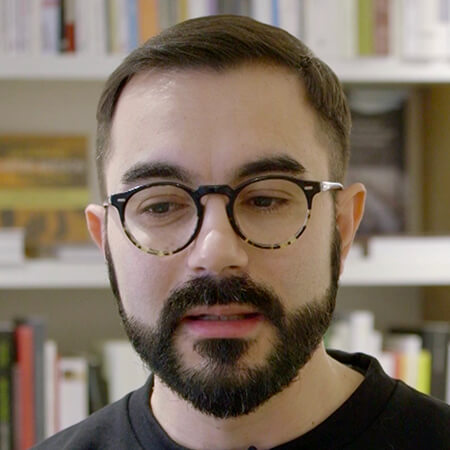
Satellite 11 : une programmation d'Agnès Violeau
du 06 février
au 20 mai 2018
Jeu de Paume, Paris
Portrait filmé
Damir Očko
Damir Očko invite à parcourir les méandres du langage et la manière dont le système neurophysiologique le génère avec poésie. Ses œuvres s’inscrivent dans un corpus d’idées où les éléments se répondent les uns aux autres, entre désir et carence, réel et fiction.
Le novlangue d’Orwell, qui prône une non-distanciation avec les faits, regroupe trois classes de vocabulaire. Le groupe B, celui de la rhétorique, de la parole politique, est le terreau du projet proposé par Damir Očko.
L’exposition du Jeu de Paume s’articule autour du film Dicta II (pluriel de « dictum », latin pour dicton, le terme qualifie une vérité non remise en question). Faisant suite à Dicta I, réalisé autour des écrits autobiographiques de Bertolt Brecht Telling the Truth: 5 Difficulties (1934), rédigés lorsque ce dernier s’est vu dénaturalisé par le régime
allemand, Dicta II se construit autour d’une série de mots d’alerte. D’influence conceptuelle et dadaïste, le film prend la forme d’un collage et regroupe un ensemble de déclarations inaudibles et contradictoires, aussi obscures que son image.
Damir Očko was born in 1977 in Zagreb (Croatia), where he lives and works today. His work is an invitation to explore the intricacies of language and the way in which the neurophysiological
system generates it so poetically. His various works fall within a corpus of ideas where the elements
respond to each other, vacillating between desire and deprivation, reality and fiction.
Orwell’s Newspeak, which advocated a non-distantiation from the facts, grouped together three types of vocabulary. Language within the B Group concerned rhetoric or political discourse, and is the breeding ground for the project proposed by Damir Očko.
The exhibition at the Jeu de Paume revolves around the film Dicta (the plural of ‘dictum’, coming from the Latin, meaning an undisputed truth). Following Dicta I, based on the autobiographical writings of Bertolt Brecht’s Telling the Truth: 5 Difficulties (1934), written when the latter fled the German regime, Dicta II is built around a series of safewords. Influenced by
Dadaism and conceptual art, the film takes the form of a collage and regroups an ensemble of inaudible and contradictory statements, as obscure as the images.
